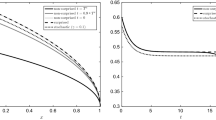Abstract
The paper considers a market in which two firms compete on advertising over time. Each firm can use three types of advertising: offensive advertising which attempts to attract customers from the rival firm, defensive advertising which aims at protecting a firm’s customer base from the rival’s attacks, and generic advertising to make industry sales grow. We address questions like: How should a strategy for the simultaneous use of the three types of advertising be designed? How would the resulting time paths of sales look like? The paper studies a differential game played over an infinite time horizon and provides closed-form expressions for equilibrium advertising strategies and sales rate trajectories.
Access this chapter
Tax calculation will be finalised at checkout
Purchases are for personal use only
Similar content being viewed by others
Notes
- 1.
Martín-Herrán et al. (2012) also use a linear formulation of attraction rates. Moreover, they include multiplicative interaction between offensive and defensive advertising.
- 2.
It holds that C 1 ≠ 0, C 1 ≠ C 2 because C 1 < 0 and C 1 < C 2. Roots are real since \(4C\left (C_{2} - C_{1}\right ) + 1> 0\).
References
Bass, F. M., Krishnamoorthy, A., Prasad, A., & Sethi, S. P. (2005a). Generic and brand advertising strategies in a dynamic duopoly. Marketing Science, 24(4), 556–568.
Bass, F. M., Krishnamoorthy, A., Prasad, A., & Sethi, S. P. (2005b). Advertising competition with market expansion for finite horizon Firms. Journal of Industrial and Management Optimization, 1(1), 1–19.
Dearden, J. A., & Lilien, G. L. (2001). Advertising co-opetition: Who pays? Who gains?. In M. R. Baye & J. P. Nelson (Eds.), Advances in applied microeconomics (Vol. 10, pp. 203–219). Amsterdam: JAI Press.
Erickson, G. M. (1993). Offensive and defensive marketing: Closed-loop duopoly strategies. Marketing Letters, 4, 285–295.
Espinosa, M. P., & Mariel, P. (2001). A model of optimal advertising expenditures in a dynamic duopoly. Atlantic Economic Journal, 29, 135–161.
Fruchter, G. E. (1999). Oligopoly advertising strategies with market expansion. Optimal Control Applications and Methods, 20, 199–211.
Huang, J., Leng, M., & Liang, L. (2012). Recent developments in Dynamic advertising research. European Journal of Operational Research, 220(3), 591–609.
Jørgensen, S., & Sigué, S. P. (2015). Defensive, offensive, and generic advertising in a Lanchester model with market growth. Dynamic Games and Applications, 5(4), 523–539.
Jørgensen, S., & Zaccour, G. (2004). Differential games in marketing. Boston: Kluwer Academic.
Martín-Herrán, G., McQuitty, S., & Sigué, S. P. (2012). Offensive versus defensive marketing: What is the optimal spending allocation? International Journal of Research in Marketing, 29, 210–219.
Piga, C. (1998). A dynamic model of advertising and product differentiation. Review of Industrial Organization, 13, 509–522.
Sorger, G. (1989). Competitive dynamic advertising: A modification of the Case game. Journal of Economic Dynamics and Control, 13, 55–80.
Wang, Q., & Wu, A. (2001). A duopolistic model of dynamic competitive advertising. European Journal of Operational Research, 128, 213–226.
Author information
Authors and Affiliations
Corresponding author
Editor information
Editors and Affiliations
Appendix
Appendix
Nonnegativity of Attraction Rates If a i > 0, d j > 0, attraction rates are given by
and invoking (6) we have \(f_{i}\left (a_{i},d_{j}\right )> 0\) if φ −ψ > 0. Lemma 1 shows that given (6), the difference φ −ψ is positive and hence attraction rates are positive. Q.E.D.
Proof of Lemma 1 Using (11) provides
Our assumption \(\beta ^{2}/c_{a}>\lambda ^{2}/c_{d}\) implies C 1 − C 2 < 0 and hence φ −ψ > 0. Q.E.D.
Proof of Proposition 1 In Case 1, ψ > 0 follows from (10). Using ψ > 0 and φ −ψ > 0 shows that φ > 0 and then φ +ψ > 0. In Case 2, ψ < 0 follows from (10). The result in (12) is established by using (10) and the fact that B > b. Offensive and defensive advertising rates are positive in both cases since φ > ψ. The generic advertising rate g is positive in Case 1. In Case 2, use (11) to see that g is positive if C > B, zero if C ≤ B. Q.E.D.
Rights and permissions
Copyright information
© 2016 Springer International Publishing Switzerland
About this chapter
Cite this chapter
Jørgensen, S., Sigué, S.P. (2016). A Dynamic Advertising Game with Market Growth. In: Dawid, H., Doerner, K., Feichtinger, G., Kort, P., Seidl, A. (eds) Dynamic Perspectives on Managerial Decision Making. Dynamic Modeling and Econometrics in Economics and Finance, vol 22. Springer, Cham. https://doi.org/10.1007/978-3-319-39120-5_5
Download citation
DOI: https://doi.org/10.1007/978-3-319-39120-5_5
Published:
Publisher Name: Springer, Cham
Print ISBN: 978-3-319-39118-2
Online ISBN: 978-3-319-39120-5
eBook Packages: Business and ManagementBusiness and Management (R0)







